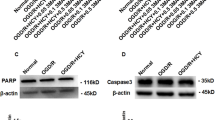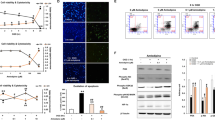Abstract
Increased blood plasma concentration of the sulphur amino acid homocysteine (Hcy) is considered as an independent risk factor of the neurodegenerative diseases. However, the detailed molecular mechanisms by which Hcy leads to neurotoxicity have yet to be clarified. Recent research has suggested that neurotoxicity of Hcy may involve negative regulation of neural stem cell (NSC) proliferation. In the current study, primary NSCs were isolated from neonatal rat brain hippocampus and the inhibition in cell growth was observed after exposure to l50 μM and 500 μM L-Hcy. The changes in protein expression were monitored with densitometric 2D–gel electrophoresis coupled with MALDI-TOF mass spectrometry. Proteomic analysis revealed that the expression levels of two mitochondrial proteins, cytochrome bc1 complex2 (UQCRC2, the major component of electron transport chain complex III) and aconitase (an enzyme involved in the tricarboxylic acid cycle), were decreased in Hcy treatment group, compared to control group. Protein expression was further verified by Western blot, and their enzymatic activities were also down-regulated in NSCs after Hcy treatment. Restoration of aconitase and UQCRC2 protein levels using their expression vectors could partly rescue the cell viability inhibition caused by Hcy. Moreover, Hcy caused the increase in the intracellular levels of reactive oxygen species (ROS) and the decrease in ATP content, which are known to play important roles in the cellular stress response of the cell growth. Altogether, the results suggest that the decreased expression and enzymatic activities of the mitochondrial proteins may be possible causes of the overproduction of ROS and depletion of ATP. The inhibition in cell growth at the end of Hcy treatment was probably due to the changes in protein expression and mitochondrial dysfunction in vitro cultures of NSCs.





Similar content being viewed by others
References
Blanchetot C, Boonstra J (2008) The ROS-NOX connection in cancer and angiogenesis. Crit Rev Eukaryot Gene Expr 18:35–45
Blom HJ (2000) Consequences of homocysteine export and oxidation in the vascular system. Semin Thromb Hemost 26:227–232
Bulteau AL, Ikeda-Saito M, Szweda LI (2003) Redox-dependent modulation of aconitase activity in intact mitochondria. Biochemistry 42:14846–14855
Chen Q, Lesnefsky EJ (2006) Depletion of cardiolipin and cytochrome c during ischemia increases hydrogen peroxide production from the electron transport chain. Free Radic Biol Med 40:976–982
Chen Q, Vazquez EJ, Moghaddas S, Hoppel CL, Lesnefsky EJ (2003) Production of reactive oxygen species by mitochondria: central role of complex III. J Biol Chem 278:36027–36031
Choi NY, Choi H, Park HH, Lee EH, Yu HJ, Lee KY, Joo Lee Y, Koh SH (2014) Neuroprotective effects of amlodipine besylate and benidipine hydrochloride on oxidative stress-injured neural stem cells. Brain Res 1551:1–12
Gardner PR, Raineri I, Epstein LB, White CW (1995) Superoxide radical and iron modulate aconitase activity in mammalian cells. J Biol Chem 270:13399–13405
Ge XY, Yang LQ, Jiang Y, Yang WW, Fu J, Li SL (2014) Reactive oxygen species and autophagy associated apoptosis and limitation of clonogenic survival induced by zoledronic acid in salivary adenoid cystic carcinoma cell line SACC-83. PLoS One 9:e101207
Han D, Canali R, Garcia J, Aguilera R, Gallaher TK, Cadenas E (2005) Sites and mechanisms of aconitase inactivation by peroxynitrite: modulation by citrate and glutathione. Biochemistry 44:11986–11996
Hirst J, King MS, Pryde KR (2008) The production of reactive oxygen species by complex I. Biochem Soc Trans 36:976–980
Huang CW, Chang WN, Huang SH, Lui CC, Chen NC, Chang YT, Lee CC, Chang CC, Chang AY (2013) Impact of homocysteine on cortical perfusion and cognitive decline in mild Alzheimer’s dementia. Eur J Neurol 20:1191–1197
Jakubowski H, Zhang L, Bardeguez A, Aviv A (2000) Homocysteine thiolactone and protein homocysteinylation in human endothelial cells: implications for atherosclerosis. Circ Res 87:45–51
Kalluri HS, Dempsey RJ (2014) D609-mediated inhibition of ATP synthesis in neural progenitor cells. Neuroreport 25:777–781
Koszczol C, Bernardo K, Krönke M, Krut O (2006) Subinhibitory quinupristin/dalfopristin attenuates virulence of Staphylococcus aureus. J Antimicrob Chemother 58:564–574
Kushnareva YE, Wiley SE, Ward MW, Andreyev AY, Murphy AN (2005) Excitotoxic injury to mitochondria isolated from cultured neurons. J Biol Chem 280:28894–28902
Lin N, Qin S, Luo S, Cui S, Huang G, Zhang X (2014) Homocysteine induces cytotoxicity and proliferation inhibition in neural stem cells via DNA methylation in vitro. FEBS J 281(8):2088–2096
Madhavan L, Ourednik V, Ourednik J (2006) Increased “vigilance” of antioxidant mechanisms in neural stem cells potentiates their capability to resist oxidative stress. Stem Cells 24:2110–2119
Maler JM, Seifert W, Hüther G, Wiltfang J, Rüther E, Kornhuber J, Bleich S (2003) Homocysteine induces cell death of rat astrocytes in vitro. Neurosci Lett 347:85–88
Misra HP (1974) Generation of superoxide free radical during the autoxidation of thiols. J Biol Chem 249:2151–2155
Myers CR, Antholine WE, Myers JM (2010) The pro-oxidant chromium (VI) inhibits mitochondrial complex I, complex II, and aconitase in the bronchial epithelium: EPR markers for Fe-S proteins. Free Radic Biol Med 49:1903–1915
Poddar R, Paul S (2009) Homocysteine-NMDA receptor-mediated activation of extracellular signal-regulated kinase leads to neuronal cell death. J Neurochem 110:1095–1106
Rabaneda LG, Carrasco M, López-Toledano MA, Murillo-Carretero M, Ruiz FA, Estrada C, Castro C (2008) Homocysteine inhibits proliferation of neuronal precursors in the mouse adult brain by impairing the basic fibroblast growth factor signaling cascade and reducing extracellular regulated kinase 1/2-dependent cyclin E expression. FASEB J 22:3823–3835
Raszewski G, Chwedorowicz R, Chwedorowicz A, Gustaw Rothenberg K (2016) Homocysteine, antioxidant vitamins and lipids as biomarkers of neurodegeneration in Alzheimer’s disease versus non-Alzheimer’s dementia. Ann Agric Environ Med 23:193–196
Ray PD, Huang BW, Tsuji Y (2012) Reactive oxygen species (ROS) homeostasis and redox regulation in cellular signaling. Cell Signal 24:981–990
Shevchenko A, Wilm M, Vorm O, Mann M (1996) Mass spectrometric sequencing of proteins silver-stained polyacrylamide gels. Anal Chem 68:850–858
Wang J, Bai X, Chen Y, Zhao Y, Liu X (2012) Homocysteine induces apoptosis of rat hippocampal neurons by inhibiting 14-3-3ε expression and activating calcineurin. PLoS One 7:e48247
Yan H, Zhang X, Luo S, Liu H, Wang X, Gao Y, Wilson JX, Huang G (2013) Effects of homocysteine on ERK signaling and cell proliferation in fetal neural stem cells in vitro. Cell Biochem Biophys 66:131–137
Acknowledgements
This work was supported by the grants from the National Natural Science Foundation of China (81373003, 81130053).
Author information
Authors and Affiliations
Corresponding author
Rights and permissions
About this article
Cite this article
Zhang, XM., Zhao, YQ., Yan, H. et al. Inhibitory effect of homocysteine on rat neural stem cell growth in vitro is associated with reduced protein levels and enzymatic activities of aconitase and respiratory complex III. J Bioenerg Biomembr 49, 131–138 (2017). https://doi.org/10.1007/s10863-016-9688-2
Received:
Accepted:
Published:
Issue Date:
DOI: https://doi.org/10.1007/s10863-016-9688-2




